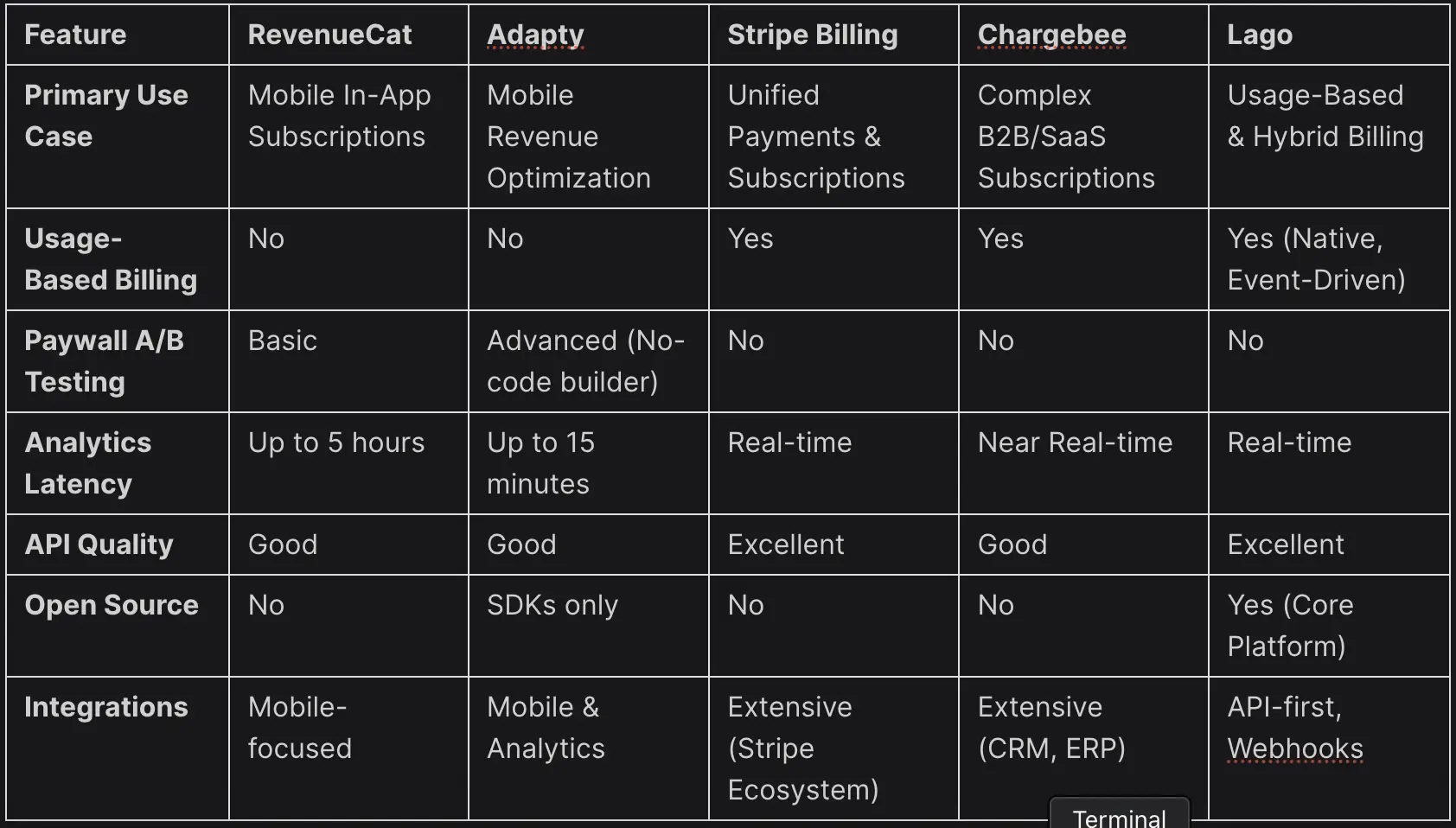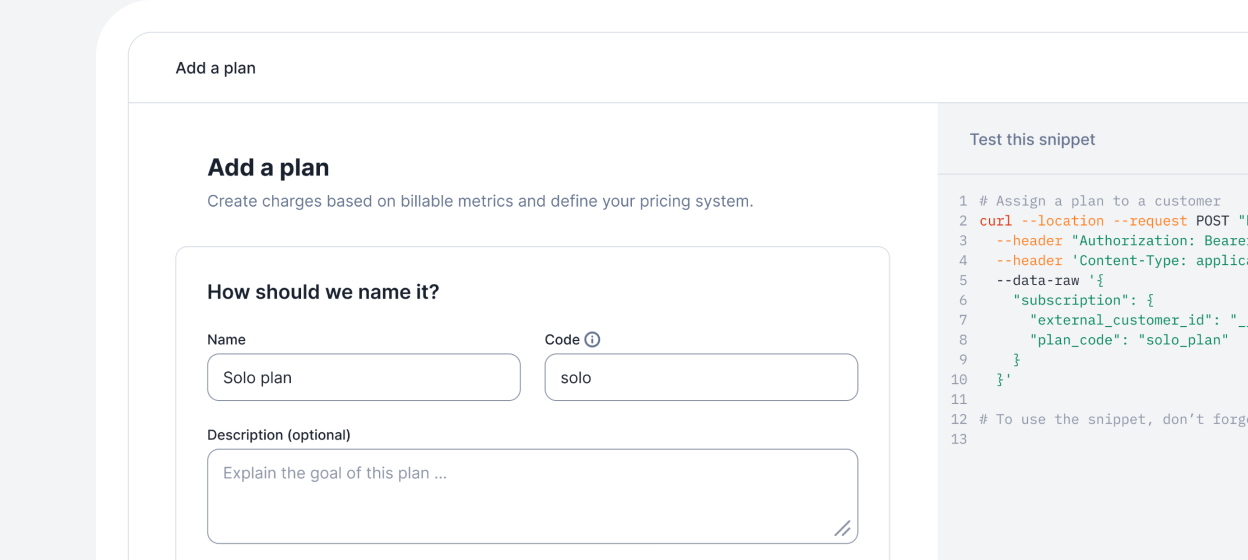Choosing the Best RevenueCat Alternative in 2025

As businesses scale, the limitations of initial billing solutions like RevenueCat often become apparent, especially for companies with complex, usage-based, or hybrid pricing models. While RevenueCat excels at managing in-app mobile subscriptions, the need for more robust alternatives arises when dealing with B2B SaaS, intricate metering, or the desire for a more extensible, API-first architecture. Leading alternatives such as Stripe Billing, Chargebee, and modern, developer-centric platforms like Lago offer advanced capabilities to handle these complex scenarios, enabling faster time-to-cash and reducing revenue leakage from billing errors.
This analysis provides a technical comparison of top RevenueCat alternatives, focusing on architectural flexibility, developer experience, and the ability to support sophisticated billing logic.
Key Evaluation Criteria for a Billing Platform
Selecting a billing platform is a critical infrastructure decision. The right choice depends on your business model, technical stack, and growth trajectory. Key evaluation criteria include billing model flexibility, integration capabilities, and the depth of analytics[1].
Billing Model Flexibility
Modern software companies are moving beyond simple flat-rate subscriptions. The ability to implement diverse pricing strategies is crucial for maximizing average revenue per user (ARPU) and reducing churn[2].
- Usage-Based & Metered Billing: This model, where customers pay based on consumption (e.g., API calls, data storage, compute hours), is increasingly popular in SaaS. It requires a platform with a robust event-ingestion and metering engine. Platforms like Lago are built specifically for this, processing high-volume event streams in real-time to ensure accurate invoicing[3].
- Tiered & Per-Seat Billing: A common model that offers predictable revenue. Most platforms, including Stripe Billing and Chargebee, handle this well. The key differentiator is the ease of creating and modifying tiers via API.
- Hybrid Models: Combining a flat-rate base fee with usage-based overages offers the best of both worlds: predictable revenue and scalable pricing. Implementing this requires a flexible architecture that can aggregate different charge types onto a single invoice.
Developer Experience and Integration
A billing system must integrate seamlessly into your existing technology stack. A well-documented, intuitive API is non-negotiable for engineering teams.
- API & SDK Quality: A clean, logical API reduces implementation time and maintenance overhead. Stripe is widely recognized for its high-quality API and documentation. Open-source platforms like Lago offer maximum transparency and control, allowing developers to understand and even contribute to the core logic.
- Integration Capabilities: The platform must connect with your core business systems, such as CRMs (Salesforce) and ERPs. Look for pre-built connectors and webhook systems that allow for custom workflows[1].
- Data Portability: Avoid vendor lock-in. Ensure you can easily export historical billing and subscription data. This is critical for future migrations or for feeding data into an internal data warehouse.
Analytics and Monetization Tools
Data-driven insights are essential for optimizing revenue. The depth and timeliness of analytics vary significantly between platforms.
- Real-Time Analytics: For mobile apps, real-time subscription events are crucial. Adapty provides analytics with a delay of up to 15 minutes, whereas RevenueCat's can be up to 5 hours. This latency impacts the ability to react quickly to churn signals or conversion trends.
- Paywall A/B Testing: For consumer-facing apps, the ability to test every element of a paywall—prices, copy, images, and product positioning—can directly increase revenue. Adapty offers a no-code paywall builder and advanced A/B testing capabilities, allowing marketing teams to run experiments without developer intervention[4].
- Cohort Analysis & LTV: Understanding user behavior over time is key to sustainable growth. Advanced platforms provide detailed cohort analysis, segmenting users by attribution source, country, or subscription plan to calculate accurate LTV and ROI.
Comparative Analysis of Top RevenueCat Alternatives
The market for billing platforms is diverse, with solutions tailored to different business models. Here’s a breakdown of the leading contenders.
For Mobile-First Subscription Apps: Adapty
For businesses focused exclusively on iOS and Android in-app purchases, Adapty presents a compelling alternative to RevenueCat. Its primary value proposition is its suite of monetization tools designed to increase mobile revenue.
- Key Strength: Advanced, no-code paywall A/B testing. Clients have reported revenue increases by systematically optimizing their paywalls[4].
- Analytics: Offers 18 essential metrics (vs. RevenueCat's 7), including detailed breakdowns of trials, grace periods, and billing issues, with near real-time data updates.
- Developer Focus: Provides a lightweight, open-source SDK that simplifies the integration of StoreKit and Google Play Billing, reducing development time.
For General Subscription Management: Stripe Billing & Chargebee
For businesses that need a versatile platform to manage subscriptions across web and mobile, Stripe Billing and Chargebee are established leaders.
- Stripe Billing: As part of the broader Stripe ecosystem, it offers seamless integration with payment processing. It features a powerful, developer-friendly API for implementing tiered, metered, and recurring billing. However, its fees can be higher for businesses at scale[5].
- Chargebee: Excels at handling complex subscription logic, dunning management, and global compliance (tax and regulations). It is often favored by B2B SaaS companies that require sophisticated entitlement and billing workflows[6].
For Complex & Usage-Based Billing: Lago
For businesses with event-driven, usage-based, or complex hybrid billing models, Lago is an open-source, API-first platform designed for scalability and accuracy. It is architected to handle high-volume event data, making it a strong alternative to both Stripe and Chargebee for specific use cases.
- Event-Based Architecture: Lago ingests raw usage events from your application via its API. These events are then aggregated in real-time according to the rules defined in your pricing plans. This ensures that invoicing is always precise, eliminating common billing errors associated with batch-based systems.
- Developer-Centric & Open-Source: Lago is built for engineers. Its transparent, open-source nature provides ultimate flexibility and control. The platform is primarily delivered as a managed cloud service, ensuring compliance and reliability, with a self-hosted option available for enterprises requiring maximum data control.
- Business Outcome: By providing a reliable and scalable metering infrastructure, Lago enables businesses to launch and iterate on complex pricing models faster. This accelerates time-to-cash for new products and provides the financial infrastructure needed to support high-growth, product-led companies.
Feature Comparison: RevenueCat vs. Leading Alternatives

Migrating Your Billing System: A Technical Overview
Switching billing providers is a significant undertaking that requires careful planning and execution. While many former RevenueCat users have successfully migrated to platforms like Adapty or Lago, the process must be managed methodically.
- Data Scoping and Export: Begin by defining the scope of historical data to be migrated (e.g., active subscriptions, customer records, payment history). Use the existing platform's API or export tools to extract this data into a structured format (e.g., CSV, JSON).
- Parallel Integration: Integrate the new platform's SDK or API into a separate branch of your application. Run the new and old systems in parallel for a cohort of users to validate data accuracy and functionality without impacting production.
- Historical Data Import: Work with the new provider's support or success team to import the historical data. This step is critical for maintaining subscription continuity and accurate LTV calculations.
- Go-Live and Decommissioning: Once the new system is validated, release the updated application to all users. Monitor the system closely for any issues. After a period of stability, you can safely decommission the old billing infrastructure.
Focus on building, not billing
Whether you choose premium or host the open-source version, you'll never worry about billing again.
Lago Premium
The optimal solution for teams with control and flexibility.

Lago Open Source
The optimal solution for small projects.

